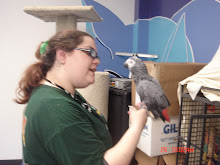
This room is full of birds and other exotic animals that were rescued from Galveston Island after Hurricane Ike
Hurricane Season is officially here for the Atlantic Basin and the first Tropical Low has formed.
What does this mean for bird owners like myself?
It means it's time to double check your preparations and put the finishing touches on training the behaviors that will help you in the event of an emergency.
But don't panic... if you are not prepared with an emergency kit and have not thought about what behaviors will be helpful in an emergency, it's not too late!
Here is a parrot disaster kit list that I put together with Code 3 Associates:
Food and Water
Food; two weeks supply – pelleted diets, seeds, dried fruits/veggies and nuts – in airtight container, rotated every 3 months
Small tubs of fruit salad in own juice is great as they provide fresh fruit and fluids but keep a long time.
Certain Baby foods are also good as they are mushy which is a comfort food for birds. Be careful as to vitamin and mineral supplementation which may be too high for a bird
Your birds favorite teats – rotated every 3 mo
Water; two week supply – estimate 1 to 2 quarts per day for drinking, bathing and cleaning
Food and water dishes – have extra and non breakable
Restraint and ID
ID - band number or microchip – have this information on your paperwork
Towels - wrap the avian in
Portable cage with perches - marked with your contact info
Recent photographs - including you or family member in picture
Wire, pliers, and duct tape – to repair portable cage
Wire cutters - to remove a stuck bird in an emergency
Sanitation
Newspapers for lining the cage
Paper towels
Dish soap
Disinfectant
Garbage bags
Care and Comfort
Blanket or sheet to cover cage
Toys
Hot water bottle
Flashlight w/extra batteries
Grooming supplies
Spray bottle for misting
Battery Powered fan - a small one can be attached to the cage and make the difference on a hot day
Records and medications
Vet phone number
Copies of proof of ownership papers
Copies of medical records
Medication – two week supply of any medication the bird is on
First aid Kit –
First aid book for Birds
3 X 5 conforming bandages
4 X 4 gauze pads
Graze rolls
Antiseptic wipes
Triple antibiotic cream
Q-tips
Scissors
Tweezers
Instant cold pack
Disposable gloves
Two rolls of vet wrap
Items in addition to basic kit
Pedialyte
Blunt nose scissors
Styptic powder
Cornflower – to stop bleeding on wings or soft tissue
Hemostat - for pulling broken blood feathers
Cotton swabs
Feeding syringes - incase hand feeding is needed)
NOTE: Birds are better being transported in the plastic animal kennels with a low perch, however this is not suitable for any longer than a day at the very most as most birds can chew through the plastic in short order.
Similarly cages (either small regular ones or collapsible travel ones) are dangerous for travel as the bird can easily panic and break wings or get them stuck in the bars.
Two cages are best, a travel cage and a collapsible wire one for when the destination has been reached.
Keep the disaster kit in an easy to grab and go bag or tub that is in a central location. If there the entrance that you keep the kit at is blocked it won't be of much use.
Make sure you know the best way to pack your car with people, animals, and supplies for both. Then be sure to plan at least 3 different routes out of town to your intended destinations (have more than one of these too!).
Finally make sure everyone in the family knows the plan.
If you must leave without your animals make sure you leave some indication on your house that you have animals and how many of each species. Inside the home in an obvious position leave basic care instructions, your emergency contact number, your out of state contact number and your vets number. This will allow emergency responders to care for your animals and get in contact with you.
Next post I will cover some behaviors which you can train to help you and emergency responders in an emergency.


